Soul Calibur V – Review
by Dom
|
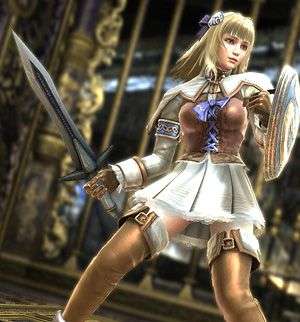 It’s generally agreed that the fighting game genre is evolving at a steady pace – more recent releases like Ultimate Marvel Vs Capcom 3 and Street Fighter IV: Arcade Edition have fleshed out the 2D-Fighter and instilled a much needed breath of fresh air into a stagnating genre. 3D-Fighters, on the other hand, seem to have nestled into a groove and solidified – carving out a very intimate and defined sense of who they are. Titles such as Tekken and Soul Calibur haven’t really changed all that much since coming to this generation; every new release brings a few cosmetic changes, but the fundamentals seem to remain the same. You could pick up a copy of Tekken 6, for example, and then move to play Tekken 3 without much really changing, aside from the frame-rate and graphics. Compare that to something like Street Fighter or Mortal Kombat (where going back to an older instalment would probably throw you off quite a lot) and you can see the difference between how 2D-Fighters and 3D-Fighters have evolved.
It’s generally agreed that the fighting game genre is evolving at a steady pace – more recent releases like Ultimate Marvel Vs Capcom 3 and Street Fighter IV: Arcade Edition have fleshed out the 2D-Fighter and instilled a much needed breath of fresh air into a stagnating genre. 3D-Fighters, on the other hand, seem to have nestled into a groove and solidified – carving out a very intimate and defined sense of who they are. Titles such as Tekken and Soul Calibur haven’t really changed all that much since coming to this generation; every new release brings a few cosmetic changes, but the fundamentals seem to remain the same. You could pick up a copy of Tekken 6, for example, and then move to play Tekken 3 without much really changing, aside from the frame-rate and graphics. Compare that to something like Street Fighter or Mortal Kombat (where going back to an older instalment would probably throw you off quite a lot) and you can see the difference between how 2D-Fighters and 3D-Fighters have evolved.
Unfortunately, Soul Calibur V doesn’t buck this trend – it is very much a shinier, more refined version of its predecessor. A lot of people in the online communities have been mouthing off about this but, personally, I don’t see a problem – I agree with the common maxim “if it ain’t broke, don’t fix it”. Soul Calibur has always prided itself on the frenetic, fast-paced nature of the combat, and the fifth instalment doesn’t disappoint long-term fans with this. The combat flows so smoothly and nicely, it’s sometimes a little difficult to see exactly what’s happening, which means you’ll find yourself often studying the replays to see exactly where people broke through your guard or took advantage of an opening you left. You think this would be annoying, but the unpredictable, feverish pace of the combat actually means you’ll find yourself relying on moves that take advantage of your opponents – maximizing your attack when possible – rather than trying to spam out juggle combos or use cheap tactics to force your opponents into submission.
The control scheme has remained exactly the same as previous instalments, with attacks broken down into horizontal (which are usually quick and weak), vertical (stronger, but more precise), kicks (auxiliary) and simultaneous press moves (which tend to be the more powerful aerial or ground attacks). When weaved together, these different types of moves can be exploited; using horizontal attacks to lead into stronger, vertical based-combos, for example. Then you’ve got the new Street Fighter inspired power bars that charge up with every bit of damage given or received. These can be saved up and delivered in the forms of ‘Critical Edges’ (basically supers) and ‘Brave Edges’ (powered-up regular attacks), and adds a new dimension to the series. This sounds complex, but Soul Calibur is surprisingly forgiving to new players and even gives a brief introduction in the new (and admittedly awful) Story Mode.
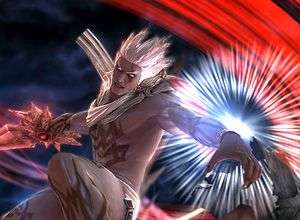 Story Mode seems like it was thrown together as an afterthought, and only really serves to explain the validity of the new characters. The writing is appalling; there is no other way of saying it. Every piece of dialogue has been thrown together from bits of old clichés, and the character development is shallow and unbelievable. The voice acting is often cringe-worthy and upsetting. Namco have changed the English actors since SCIV and it shows. The previously mischievous and unsettling voice of Tira has become an irritating and shrill whine, while Ivy’s previous mellow, sarcastic timbre has been shifted to an arrogant pseudo-British throatiness, which weakens her character significantly.
Story Mode seems like it was thrown together as an afterthought, and only really serves to explain the validity of the new characters. The writing is appalling; there is no other way of saying it. Every piece of dialogue has been thrown together from bits of old clichés, and the character development is shallow and unbelievable. The voice acting is often cringe-worthy and upsetting. Namco have changed the English actors since SCIV and it shows. The previously mischievous and unsettling voice of Tira has become an irritating and shrill whine, while Ivy’s previous mellow, sarcastic timbre has been shifted to an arrogant pseudo-British throatiness, which weakens her character significantly.
The story itself follows new character and main protagonist Patroklos, and his weak quest to save his sister – the deuteragonist, Pyrra. The only interesting thing throughout the whole campaign was the way it was written, stylistically. It follows all the conventions of a typical Greek drama – subscribing to all the stock character types and narrative advancements. The content within is too weak for it to matter, though – the battles in story mode are dull, the dialogue is cheesy and unfortunate and, here’s the important thing, it’s short. Very short. 18 ‘episodes’ short (but I was happy about that; it meant it was all over quickly). Namco made the exact same error with Soul Calibur V that they did with Tekken 6 – they loosely attached a flawed and shallow mode onto the main game and had the audacity to call it a “Story”. The biggest slap in the face for a long-time fan, however, is the fact you don’t even get a little bit of an ending from the Arcade mode for any characters. After my first thrash through the European Arcade route (finishing it with Tira), I was almost offended that the only reward I got for my troubles was a screen detailing my clear time and rank.
The most irritating thing about this new approach to story is the retrospective, symptomatic effect it has on the Soul Calibur franchise. There’s always been a cheesy element to the series, but this game takes the piss a little bit. It’s so cheesy it’s unreal. The way the writers have dealt with the whole universe devalues and undermines everything that’s come before – Soul Calibur V negatively impacts the rest of the canon. It’s upsetting that a game that previously had a lot of depth to the story, a rich universe with deep and well-realized characters has resorted to such a shallow and transparent tactics to impart narrative. The rich mythology of Soul Calibur has been diluted to a watery concept, focussed around angsty teenagers and large-breasted young women.
The majority of people don’t buy fighting games for the story, though. The extra modes included in Soul Calibur V more than make up for the disappointing story mode; you’ve got things to cater for every different type of player: the Quick Battle feature allows you to jump into a battle against an AI personality and fight them for their ‘title’. It’s a smart, interesting system that always leaves something to offer, especially since it stores your Win/Lose ratio and allows you to search for specific criteria to fight against. You’ve also got the aforementioned Arcade mode, which gives you a few pre-selected to routes to fight through, with each one allowing you to face different characters in different stages. There isn’t really much reward to this, unless you’re trying to fight to the top of the online leaderboard with your clear time.
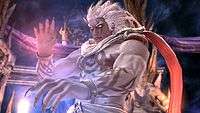 |
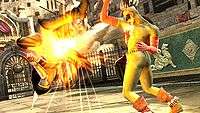 |
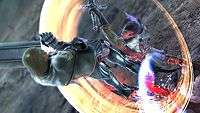 |
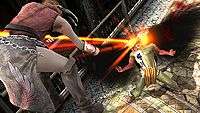 |
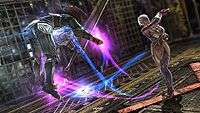 |
 |
After a while, you’ll unlock the bonus Legendary Souls mode which, basically, pits you against Boss AI from previous instalments. This mode comes with a set difficulty, and can be infuriating, but it acts as an amazing training mode. The AI is such a high level that once you figure out how to beat it, the tactics you used can be applied to different areas of the game, making some of the tougher battles more forgiving. There are some nice cameos in this mode, but it’s a little irritating seeing all these amazing character models and old-style movesets restricted to Boss AI, with no evident way to unlock them. At least there’s a reward to this mode, however; if you manage to fight through it all (and trust me, it’s very, very hard), then you’ll unlock an old face from the Soul series. And it’s a very good face to have in your roster.
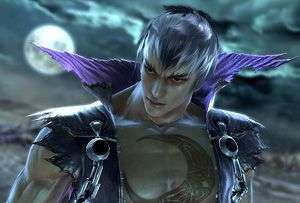 In addition to all this, you’ve got your standard fighting game modes: practice mode is exactly what you’d expect; you can fight dummies or you can set the AI up to fight you. Character creation mode is back and has undergone some serious renovations. Now, not only can you choose from the items you want to adorn your character with, but you can also alter their textures, colours and add insignia (or stickers) on to them. This widens the scope massively for character creation. It’s a fun mode, and you can create some serious, original roster-worthy characters, or stupid, wacky Saint’s Row style characters that will unnerve anyone that comes across them online.
In addition to all this, you’ve got your standard fighting game modes: practice mode is exactly what you’d expect; you can fight dummies or you can set the AI up to fight you. Character creation mode is back and has undergone some serious renovations. Now, not only can you choose from the items you want to adorn your character with, but you can also alter their textures, colours and add insignia (or stickers) on to them. This widens the scope massively for character creation. It’s a fun mode, and you can create some serious, original roster-worthy characters, or stupid, wacky Saint’s Row style characters that will unnerve anyone that comes across them online.
Incidentally, the online mode has been significantly improved since Soul Calibur IV; the lobbies have been separated into regions, and there are rooms for each individual city within the region. This allows fast, reliable connections – something often quite rare in fighting lobbies. Within the online modes, you’ve got ranked matches, player matches and the new Global Coloseo. As you’d expect, the ranked matches are filled with hardcore fighters going for rank, player matches tend to be people practising for ranked, and the Global Colosseo is full of people going for in for casual matches. It’s a nice set up – excuse the cliché, but there really is something for everyone.
The fighters in the game themselves are… varied. The roster is extensive, and there are characters that suit every play type: the slow, powerful behemoths that can swipe off half your health bar in one go are there (Astaroth, Knightmare and Siegfried), as well as the nimble, quick types that focus on getting sly attacks in during recovery times or animation frames (Raphael, Tira and Viola). What’s nice about Soul Calibur is that it goes beyond these two archetypes; you’ve got guest character Ezio Auditore (of Assassin’s Creed fame) supplying the technical, mid-power, mid-speed character. You’ve got the Taki replacement (Natsu) filling the stereotypical ninja role, with teleportation attacks and a range of quick and slow moves that make her a formidable foe. Then you’ve got the mid-range characters – the old samurai, Mitsurugi is always a popular pick; with powerful moves with short animation periods, he can easily exploit the quicker and slower characters.
An annoyance for long term fans is the exclusion/alteration of old favourites. Some characters – such as the dread pirate Cervantes – are changed only cosmetically, their move-sets remaining pretty much the same, with a few welcome extras crow-barred in. Kilik – the rod-wielding Asian pretty-boy – has been altered beyond recognition, and now acts as a Mokujin-esque character (using all male characters’ styles); his previous moveset has been altered and passed on to protégée Xiba (who handles completely differently). A few fan favourites have been completely omitted (for the time being, at least – there are talks of character DLC). Zasalamel, Talim, Setsuka and Yun-Seung have been removed, with no other characters taking the styles left by them. Some of the new additions (Greek siblings Patroklos and Pyrra, for example) don’t seem as deeply realized as their histrionic counterparts, and European newcomers Viola and Z.W.E.I (the stupidest name for a character ever) are almost unusable to me (but I’m stubborn and don’t like change).
Graphically, the game is pretty. Very, very pretty. The character models themselves are shiny (and jiggly, as you’d expect from Namco), and you can easily tell the different textures apart – metals are metallic, cottons are smooth and rich and spandex/catsuits are as, erm, tight as you’d expect. The stages are brought to life nicely, with many interesting things to watch in the backgrounds, and a lot of good design truly invigorating the environments with life. Character animations are realistic and flashy, and you can tell there has been a lot of attention placed on getting it all right. Aurally, the game is what you’d expect – soaring soundtracks filled with French horns and orchestral arrangements, the vicious clashing of swords, the whiny semi-orgasmic cries of the women, the grunts and machismo remarks of the men. The soundtrack is pleasing and, at times, nostalgic, and supplies everything you’d ask for from a fighting game set in 1607.
So, overall Soul Calibur V is a welcome addition to a relatively sparse genre – the 3D-Fighter is a rare thing in this day in age, and you only really have the choice between Soul Calibur and Tekken. Now that these two games are diverging and heading down very different paths, it means each have their own solid identities. Soul Calibur V is an amazing fighting game, and it should stick to that, rather than trying to generate the illusion that it is something… more. The mechanics behind the fighting are powerful and relevant, and the dynamic battles this creates form some of the best bouts you’ll have this generation. After my fifth encounter online (in a ranked battle), I even got a direct message from someone I just fought, thanking me for the game and saying how amazing that battle looked. I agreed, and saved the replay for posterity. Looking back at it, it seems choreographed and cinematic – when you don’t have a pad in your hand, the bouts look even faster and more hectic, the vibrant colours of characters’ clothing meshing attractively with the trails weapons leave behind. Soul Calibur V is a cracking game, and one that I’ll be playing to death for months to come.
Pros- A solid, technical fighter that is as deep as you want it to be.
- Beautifully rendered and bought to life with astonishing graphics.
- Sublime character design, with something to offer for everyone.
- Character creation is deep, rewarding and amusing.
- Online matchmaking is quick, efficient and works without a hitch.
- The Story Mode is just offensively bad. There is no other way to put it.
- Compared to older games in the series, there isn’t as much to offer.
- The voice acting has deteriorated vastly since SCIV, and is often cringy.
- Balancing issues for a few characters, making online noobs prey to spammy players.
- Ivy’s boobs are too big now. There, I said it.
Soul Calibur V is a solid, competent fighter that rewards determination and skill with fun, fast-flowing bouts. New players and veterans alike can take what they want from the game and not feel short-changed. It is a successful, social fighter that takes everything that makes fighting games great and emphasizes them, falling short in the non-essential areas.
As much as Soul Calibur V tries, it cannot present a valid or emotionally engaging storyline, and almost wanders into self-parody attempting to do so. If you’re a fan of beat-'em-ups – 2D or 3D – then this is for you. If you’re after something with complex characters and emotional investment, run away. Run very far away.
Last five articles by Dom
- Defining Games, Part I: ‘Culture’
- Best of 2012 - 10 Games and Their Classic 8-Point Story Arcs
- 10 Games and Their Classic 8-Point Story Arcs
- Tekken Tag Tournament 2 - Review
- Tom Clancy’s Ghost Recon: Future Soldier - MP, Campaign, and Film Preview















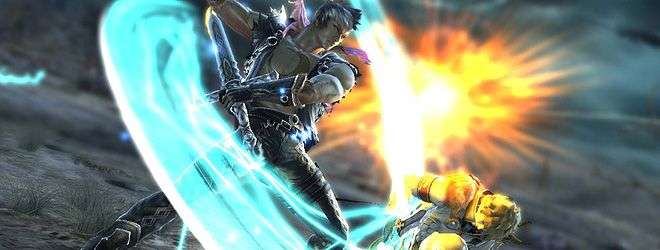
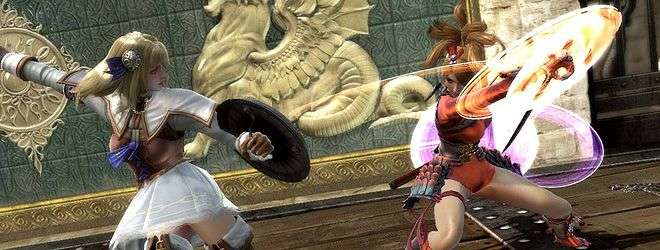
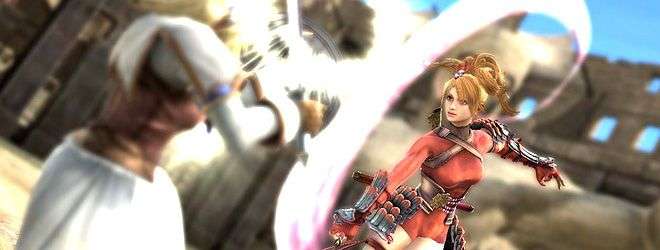
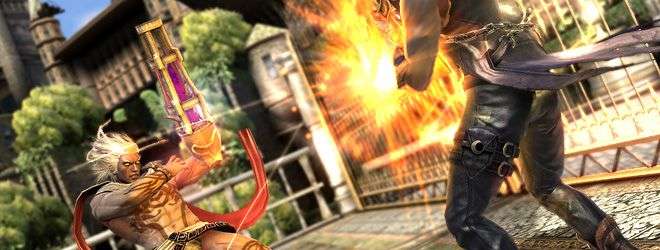






A stellar review Dom

I get what you mean about not necessarily having to play fighting games for the story, it’s a weird dilemma where you don’t want to think too much about them because you think “Hey, this is just trying to find reasons for me to hit more things”, but then when you’re on the fifth game in a series of hitting things, you don’t want it to contradict or mess anything up from before.
Otherwise, I really enjoyed Soul Calibur 2 in my younger days, though I was always shit at it, so I’ll be looking forward to playing against you on this one.
PARTY AT DOM’S HOUSE!